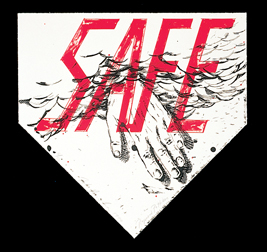home | metro silicon valley index | the arts | visual arts | review

Home sweet home: Ed Ruscha and Raymond Pettibon's 'SAFE' elevates baseball to salvation.
End Notes
Ed Ruscha and Raymond Pettibon print up a world of words at San Jose Museum of Art
By Michael S. Gant
'THIS IS THE END, beautiful friend/ ... The end of everything that stands," intoned Jim Morrison. The Lizard King's nihilism portended the L.A. punk scene of the late '70s and early '80s, the one in which Greg Ginn's band Black Flag and the record label SST played a seminal role, the L.A. punk scene for which Greg Ginn's brother, Raymond Ginn, a.k.a. Raymond Pettibon, slashed out some memorably crude posters, album covers and zines that moshed together frantic black-ink scrawls with ransom-note lettering.
As he moved from DIY underbelly fame to aboveground acclaim, Pettibon kept adding words to his drawings, words drawn from a compendious if disorderly memory bank of philosophy, literature high and low, comic books and old magazines—everything from Joyce and James to pulp and Gumby. One memorable drawing connects the disconsolate rubber man to a telling Pettibonism: "Life ceases to be either simple or innocent from the moment even one book does appeal to a critical sense." Pettibon now lives in Hermosa Beach, and judging from a recent interview with critic Michael Kimmelman, his unmoored narrative nuggets have ascended to the stoned-surfer empyrean of John From Cincinnati.
In "THE END" and The Holy Bible" now showing upstairs at the San Jose Museum of Art, Pettibon pairs off with a cooler, older customer from L.A.: artist Ed Ruscha (who is 69 to Pettibon's 50). A major pop artist who came to fame in the 1960s by elevating L.A. graphic brands into deadpan monuments—the best examples are his rendering of the spotlighted 20th Century Fox logo, his hymn to the diagonal thrusts of a typical Standard Oil gas station and his backside view of the Hollywood sign against a blood-red sunset that could be the City of Angels in flames. Ruscha's fascination with typography as art has never flagged. In his paintings, he depicts, with trompe l'oeil accuracy, words spelled out in droplets of water and blood or pieces of folded paper.
For "THE END," Pettibon and Ruscha, singly and together, ring multiple changes on a phrase that can represent either a satisfying conclusion to a good read or a marker of the apocalypse. Since the Bible plays such a big part in this show, the second meaning predominates. In two- and three-color lithographs done in multiple versions, Ruscha separates two versions of the words with a white line, the letters cut in half at the top and at the bottom. Pettibon contributes, in hand-lettered red ink, his ramblings as captions: "And there is nothing the reader can do about it"; "He has done right in letting you know the truth in time, instead of leaving you to write about it later." The effect is, in the 27 color trial proofs and other variants on display, numbing. Will it ever end, you wonder?
Wittier is Pettibon's pen, ink and acrylic drawing of a book that looks like a Bible, with "THE END" on the front cover. Ruscha contributes three rescued books (Mainstreams of Modern Art, a world atlas and a volume from the familiar pocket-size blue-bound Yale Shakespeare series) with the words painted in various lettering styles across the bindings. The books are neatly displayed in box frames—remade ready-mades.
The book motif informs "The Holy Bible" sequence, in which Ruscha paints the Holy Book and Pettibon appends opaque comments like "You will receive my other book as soon as it comes out. I am rather anxious about this one," as if the "author/God" were a nervous first-time novelist in need of reassurance. Other samples in "The Holy Bible" seem at first to be irony free. Pettibon draws a Bible and writes, "Is there no end to the wonders contained therein?" But then again, it is just a drawing, and there is no therein therein, as Gertrude Stein might have quipped. The best pun comes with a lithograph with a white-on-black pentagon in the shape of a baseball home plate. A hand touches it untagged; and the ultimate benediction—"SAFE"—is printed in large block red capital letters. For artists, that's a big relief; home is the "end" of a long journey around the bases, home is where the art is.
The Holy Bible and THE END by Ed Ruscha and Raymond Pettibon shows through Oct. 21 at the San Jose Museum of Art, 110 S. Market St., San Jose. (408.294.2787)
Send a letter to the editor about this story.
|
|
|
|
|
|